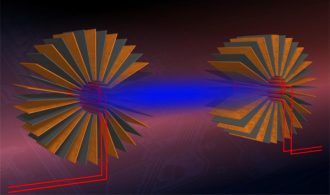
26/05/2016
UAB University Makes Distance Wireless Charging a Reality
UAB University Makes Distance Wireless Charging a Reality
Charging devices without the need of taking them out of one’s pocket is both a technologic and economic challenge.
A group of researchers from the Department of Physics of Universitat Autònoma de Barcelona, which is a Barcelona Synchrotron Park key partner, have developed a system which can efficiently transfer electrical energy between two separated circuits thanks to the use of metamaterials which combine layers of ferromagnetic materials, such as magnets, and conductor materials such as copper. The metamaterials envelop the emitter and receptor and enable transferring electrical energy between the two, at a distance and with unprecedented efficiency.
With the use of metamaterial crowns researchers were able in the lab to increase the transmission efficiency 35-fold, “and there is much more room for improvement, since theoretically the efficiency can be increased even more if conditions and the design of the experiment are perfected” explains Àlvar Sánchez, director of the research.
Published last week in Advanced Materials, the research was conducted by researchers from the Electromagnetism Group of the UAB Department of Physics Àlvar Sánchez (also an ICREA Acadèmia researcher) and Carles Navau, with the collaboration of Jordi Prat, currently researcher at the Institute for Quantum Optics and Quantum Information of the Austrian Academy of Sciences in Innsbruck.
The device has been patented by the UAB and several companies abroad have already showed interest in applying the technology to their products.
News based on the press release published by UAB.
Image: Jordi Prat, UAB
A group of researchers from the Department of Physics of Universitat Autònoma de Barcelona, which is a Barcelona Synchrotron Park key partner, have developed a system which can efficiently transfer electrical energy between two separated circuits thanks to the use of metamaterials which combine layers of ferromagnetic materials, such as magnets, and conductor materials such as copper. The metamaterials envelop the emitter and receptor and enable transferring electrical energy between the two, at a distance and with unprecedented efficiency.
With the use of metamaterial crowns researchers were able in the lab to increase the transmission efficiency 35-fold, “and there is much more room for improvement, since theoretically the efficiency can be increased even more if conditions and the design of the experiment are perfected” explains Àlvar Sánchez, director of the research.
Published last week in Advanced Materials, the research was conducted by researchers from the Electromagnetism Group of the UAB Department of Physics Àlvar Sánchez (also an ICREA Acadèmia researcher) and Carles Navau, with the collaboration of Jordi Prat, currently researcher at the Institute for Quantum Optics and Quantum Information of the Austrian Academy of Sciences in Innsbruck.
The device has been patented by the UAB and several companies abroad have already showed interest in applying the technology to their products.
News based on the press release published by UAB.
Image: Jordi Prat, UAB
More news
30/07/2014
Barcelona among the top 10 cities in the world
24/07/2014
Researchers prove the effectiveness of a new drug against malaria using synchrotron light
17/07/2014
Creation of the Health Technologies Cluster
10/07/2014
An international team of scientists led by researchers from the UAB creates the world's first magnetic hose
03/07/2014
CaixaBank and Oracle set up a Big Data Centre of Excellence in the Barcelona Synchrotron Park
26/06/2014
The Barcelona Supercomputing Center hosts two important new international projects









